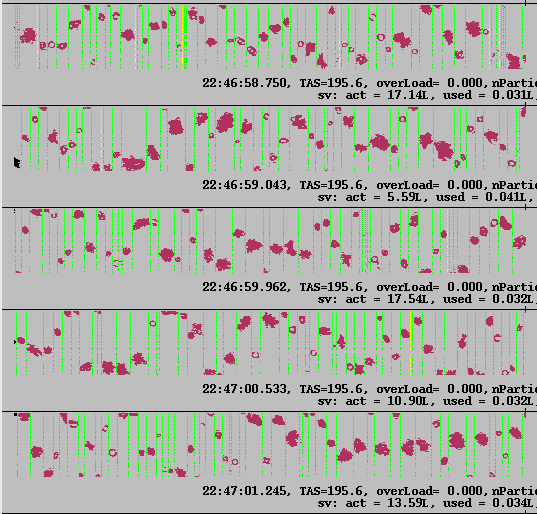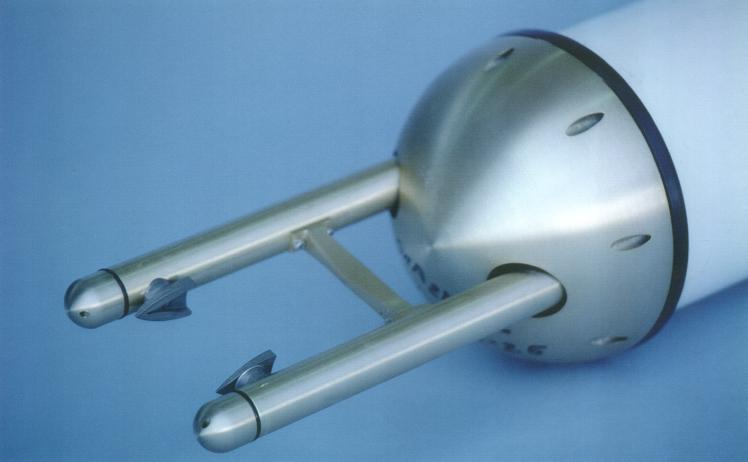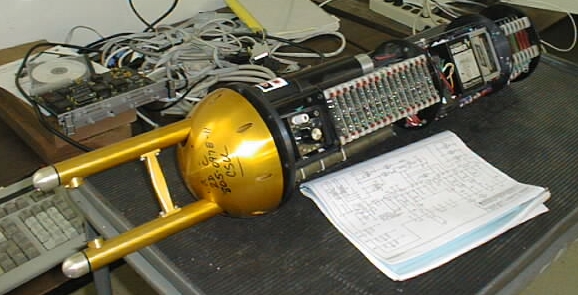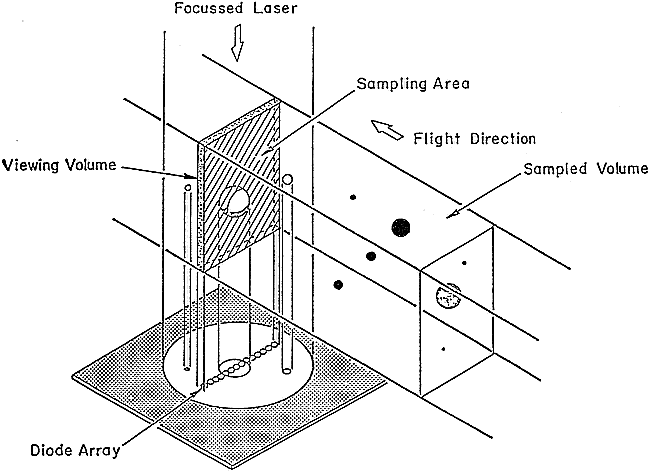Two-Dimensional Optical Array Cloud Probe
There are three general types of two-dimensional imaging probes:
- 2D-C, cloud probe, with elements representing 25 um pixels in the image. Older probes had 32 such elements for a sample aperture 0.8 mm wide; recently modified probes have 64 elements and a sample aperture of 1.6 mm. This probe is the focus of the corrent instrument page.
- 2D-P, precipitation probe, with pixels covering either 100 or 200 um on the particle image. Older 2D-P probes had 32 elements each representing 200 um pixels, for an aperture of 6.4 mm; recently modified probes have 64 100 um pixels and provide the same sample aperture. This instrument has characteristics very similar to the 2D-C probe, but there is a separate page that describes the differences.
- 2D-gray, which produces gray-scale images by recording shadowing at three different thresholds, with 25 um pixels covering an 0.8-mm aperture. This probe has not been modified for use on current high-speed aircraft and is now obsolete, but there are some projects that still archive data from this probe.
- 2D-S, which has 10 micron resolution and covers the size range from 10 to 1280 microns. This probe has its own instrumentation page.
- HVPS, which has 150 micron resolution for measuring hydrometeors larger than 150 microns.
-
The 2DC records the two-dimensional shadow cast by a hydrometeor as it passes through a laser beam. The image of the shadow is focused onto a plane containing a linear photodiode array, and the status of the elements of that array (illuminated or not) is recorded at a rate that permits reconstruction of the image. Fpr the 2DC, the array has resolution for the image of 25 micrometer along the linear array, so to provide rectangular resolution at 100 m/s the array must be sampled at 4 MHz. The 2D Probes section of RAF Bulletin 24 provides some additional information. The optical configuration is shown in the following diagram:
-
-
Optical Diagram of a 2DC probe. Additional mirrors and lenses are not shown here. The shadow of the hydrometeor passes over the diode array as the aircraft moves in the flight direction, so rapid sampling of that array records the image of the hydrometeor.
- From the recorded images, it is possible to determine size distributions and associated derived quantities, and with additional non-standard processing to classify images and recognize habits of hydrometeors. Although the minimum size detected is the size of an equivalent pixel in the array, which is 25 micrometers for a standard 2DC probe, the optical depth-of-field for the 2DC is smaller than the distance between the arms of the probe (cf. the above photograph) for hydrometeor sizes smaller than about 150 micrometers. For the original 2DC, the correction needed was also a strong function of the airspeed; see Baumgardner and Korolev (1997), referenced in the "Documentation" section below. Applying corrections for the change in sample volume is difficult, however, because the image can be mis-sized as well and if the wrong size is used to determine the depth-of-field large errors in concentration can result. Modern versions of the 2DC (used at the RAF since about 2009??) have much faster electronic circuitry and do not miss the first scan of an image as did the original version, so the corrections for small size are different from those published by Baumgardner and Korolev (1997) -- although their zero-airspeed result is a good approximation to the behavior of modern probes.
-
Measurements Provided: two-dimensional images of hydrometeors.
Measurement Characteristics:
- Resolution: Image resolution is 25 micrometeres for the standard probe. There are other versions with different resolution, including an experimental version with 10 micrometer resolution.
- Sample rate: The nominal sample rate is 4.88 liters per 100 m of flight path for hydrometeors 125 micrometers and larger, for the standard 32-element probe with 25 micrometer image resolution. Variants of the prob To detect any part of a hydrometeor, this sample volume (for the standard probe) is increased by a factor of (775 + D)/800 where D is the particle dimension (in micrometers) in the direction that is shadowed along the linear axis of the photodiode array.
-
Overall estimate of uncertainty: For sizes above 125 micrometers, the uncertainty in concentration is approximately as determined by counting statistics, but for sizes below 125 micrometers the concentrations can be in error by as much as a factor of five (arising from mis-application of the depth of field to mis-sized images). Often in processed files there is no correction for reduced depth-of-field at small sizes, so users must apply corrections or else use only the size range where the depth-of-field is limited by the sample arms (i.e., >= 125 micrometers).
- Response time: 0.25 microsecond (standard probe)
- Precision: for concentration, precision is limited by counting statistics; for sizing, precision is limited by the effective size of elements of the photodiode array (25 micrometers for the standard probe)
- Other measurement characteristics (comments on signal/noise, bias limits, etc): Shattering (in which hydrometeors strike the arms or inlet shields of the instrument and break into fragments that pass through the laser beam) can produce large numbers of erroneous images. These can be removed partly to tests applied to the inter-arrival times of images, but that does not provide a fully satisfactory correction. New probe tips have been investigated and are now installed to control this problem, but this remains an area of active investigation.
- An example of images from an all-ice region containing large crystals and aggregates is shown below:

History of Significant Changes: In about 2005, the electronics and data-transmission rates were increased to accommodate the higher airspeed of the GV. In 2011, a development is underway to provide a unit with 10-micrometer resolution.
A spinning disk with holes of known size or images of known size is used to check the size resolution.


